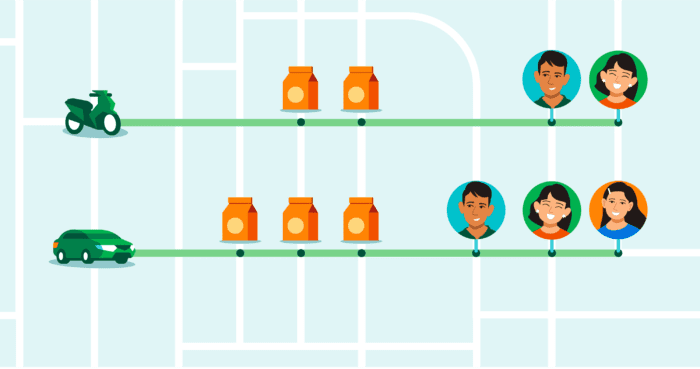In many cities across Southeast Asia, it is possible that the same driver who ferried you to work in the morning, could be the same one delivering lunch to your family at home in the afternoon and even dropping off a parcel for your colleague in the evening. After all, almost 4 out of 5 of Grab’s (NASDAQ:GRAB) two-wheel driver-partners in Indonesia, Thailand and Vietnam accept ride-hailing as well as delivery jobs on the platform.
It works for them because demand for ride-hailing, food delivery and other delivery services peak at different times of the day. By switching between different types of services, they can complete more jobs in a day and earn more.
Watch: A day in the life of a Grab driver-partner
Chusni Mubarak, who has been driving with GrabBike in Indonesia since 2017, said: “When the pandemic hit, fewer people were going out—I expanded to provide more services like GrabFood and GrabExpress, so that I can earn more, even when there are no passengers.”
While it is typical to find in Southeast Asia driver-partners like Chusni who take on ride-hailing and delivery jobs, this is less common in other parts of the world.
Southeast Asia: Where two wheels are better than four
The contrast is predicated on various cultural and structural differences. At least 80 per cent of households in Southeast Asian countries such as Malaysia, Thailand, Indonesia and Vietnam own motorcycles.

It’s an economical option, but also a highly practical one. Many locals find that the best way to get through the dense traffic that clogs many cities in Southeast Asia is on two wheels instead of four. Motorcyclists weaving through traffic with passengers riding pillion, or with goods stacked on the back, is a common sight in the region.
In Europe as well as countries like the United States, cars are the dominant mode of transport. Taking into consideration the wait times for food, the need to find a parking lot, pay parking fees, as well as fuel costs, the unit economics of food deliveries on four wheels are less attractive compared to motorcycles. Given the circumstances, car drivers tend to prefer ride-hailing jobs.
Good for drivers, good for Grab
Grab has sought to design our driver app to make it as easy as possible for driver-partners to toggle between different services, anytime they wish, whether it is GrabBike, GrabFood, GrabMart, or GrabExpress.

It maximises their earning potential by giving them the opportunity to be more productive for every minute they’re on our platform. It is also good for the business because it helps lower retention costs. In a competitive landscape, drivers will choose to give their time to the platform that helps them earn more.
Higher utilisation rates of our fleet also allows us to improve our unit economics by lowering the costs incurred to serve per ride. Achieving this has been pivotal in allowing Grab to deliver strong margins in its mobility business, while continuing to drive sustainable growth.
Maximising productivity through tech
This is bolstered by investments into building tech that aims to make the most of the time our driver-partners spend on our platform.
For example, Grab’s machine learning and predictive analytics engines know the exact moment to instruct a delivery-partner to head towards the restaurant so that they arrive just when the order is ready. This minimises dead time spent waiting for food to be prepared, and ensures that consumers get their food hotter and fresher. As a result of our innovations in this area, driver wait times in Q2 2023 were 52 per cent lower than in the same period the year before.
Our hyper-batching system allows delivery-partners to pick up two or more orders across different food outlets in one trip, and routes the sequence of orders intelligently based on factors such as traffic, weather and the time delivery-partners need to wait at the merchants.

Map tech is the foundation that helps keep Grab and its community moving. That’s why we invested in building GrabMaps, our proprietary mapping and location-based solution. Better and far more cost-effective than any third-party map solution available in the market, GrabMaps helps us assign and route our partners more efficiently, and helps guide them to their destinations quicker.
As a result of these efforts and more, in Q2 2023, earnings per transit hour of our driver-partners increased 9 per cent YoY and 4 per cent QoQ respectively, and retention rates were 90 per cent.
Productivity gains provide another benefit to our services—improving reliability for consumers. When each driver-partner becomes more productive, you essentially optimise the existing supply pool of drivers, and make Grab’s services more available and affordable for consumers.
The financial services Grab offers to driver-partners benefits the ecosystem too. About a third of Grab’s driver-partners today have an active loan with us, and our data shows that providing these loans lift productivity and retention rates.
By helping our driver-partners earn more and be more productive, we’re building a more successful, sustainable business —a superapp blueprint unique to Southeast Asia.
3 Media Close,
Singapore 138498
Komsan Chiyadis
GrabFood delivery-partner, Thailand
COVID-19 has dealt an unprecedented blow to the tourism industry, affecting the livelihoods of millions of workers. One of them was Komsan, an assistant chef in a luxury hotel based in the Srinakarin area.
As the number of tourists at the hotel plunged, he decided to sign up as a GrabFood delivery-partner to earn an alternative income. Soon after, the hotel ceased operations.
Komsan has viewed this change through an optimistic lens, calling it the perfect opportunity for him to embark on a fresh journey after his previous job. Aside from GrabFood deliveries, he now also picks up GrabExpress jobs. It can get tiring, having to shuttle between different locations, but Komsan finds it exciting. And mostly, he’s glad to get his income back on track.

